Ube University Engineering Campus: Planning and Development Report
VerifiedAdded on 2022/08/26
|5
|1503
|75
Report
AI Summary
This report details the planning and development of Ube University's engineering campus in Frankston, focusing on a 30-year vision and physical development framework. Key aspects include the campus context, precincts, built form, asset maintenance, and sustainability strategies. The campus features research and educational buildings, recreational facilities, a childcare center, and advanced technology labs. Efforts are made to enhance transportation, wayfinding, and sustainability through interconnected energy infrastructure and the incorporation of photovoltaic cells. The report also emphasizes strategies for recruiting top engineering learners and improving the quality of education through innovative curricula and professional opportunities. The application of urban design and computer modeling supports integrated designs that incorporate transport infrastructure, public space, and people's actions, aiming to create a pedestrianized, zero-carbon campus that fosters civic engagement and collaboration.
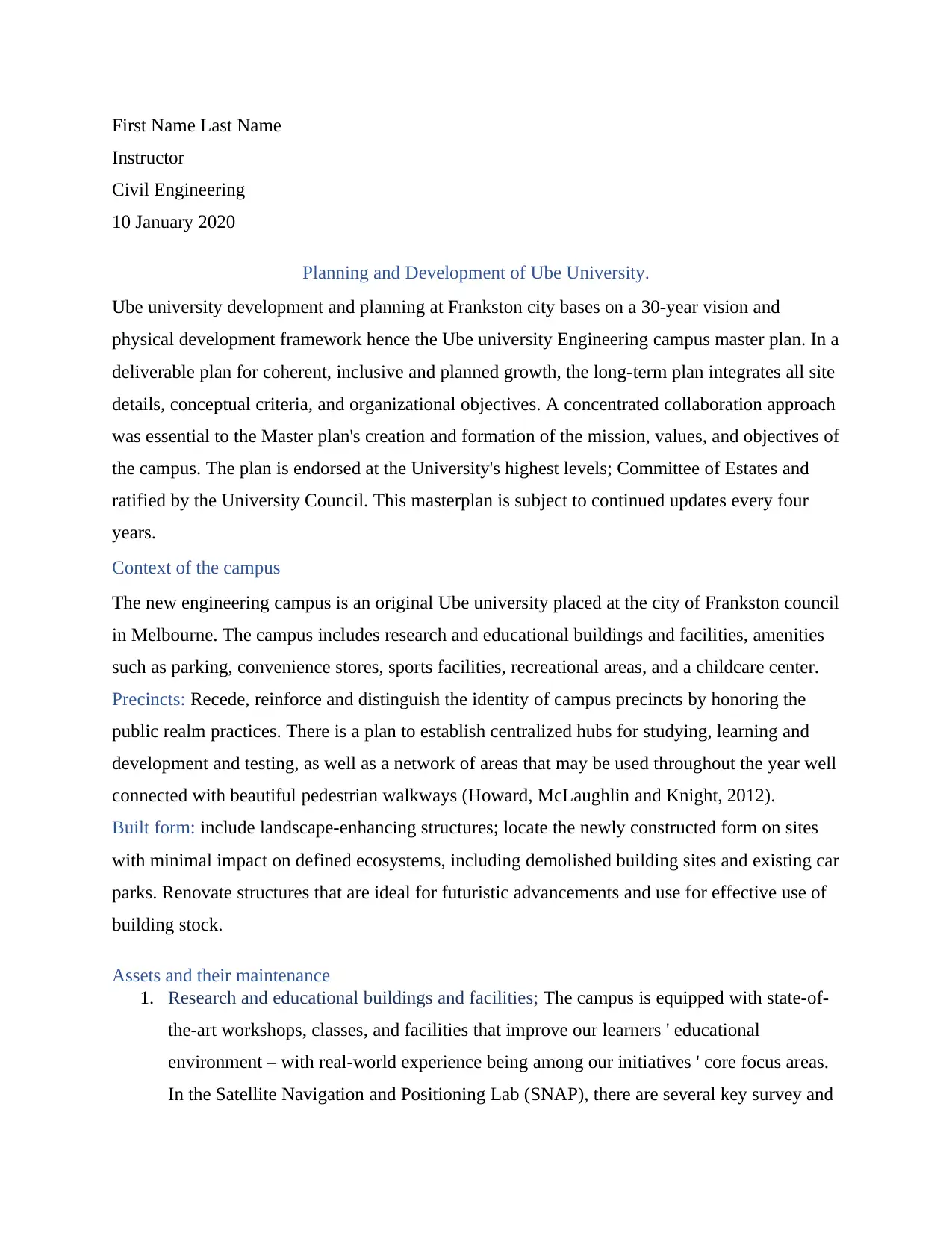
First Name Last Name
Instructor
Civil Engineering
10 January 2020
Planning and Development of Ube University.
Ube university development and planning at Frankston city bases on a 30-year vision and
physical development framework hence the Ube university Engineering campus master plan. In a
deliverable plan for coherent, inclusive and planned growth, the long-term plan integrates all site
details, conceptual criteria, and organizational objectives. A concentrated collaboration approach
was essential to the Master plan's creation and formation of the mission, values, and objectives of
the campus. The plan is endorsed at the University's highest levels; Committee of Estates and
ratified by the University Council. This masterplan is subject to continued updates every four
years.
Context of the campus
The new engineering campus is an original Ube university placed at the city of Frankston council
in Melbourne. The campus includes research and educational buildings and facilities, amenities
such as parking, convenience stores, sports facilities, recreational areas, and a childcare center.
Precincts: Recede, reinforce and distinguish the identity of campus precincts by honoring the
public realm practices. There is a plan to establish centralized hubs for studying, learning and
development and testing, as well as a network of areas that may be used throughout the year well
connected with beautiful pedestrian walkways (Howard, McLaughlin and Knight, 2012).
Built form: include landscape-enhancing structures; locate the newly constructed form on sites
with minimal impact on defined ecosystems, including demolished building sites and existing car
parks. Renovate structures that are ideal for futuristic advancements and use for effective use of
building stock.
Assets and their maintenance
1. Research and educational buildings and facilities; The campus is equipped with state-of-
the-art workshops, classes, and facilities that improve our learners ' educational
environment – with real-world experience being among our initiatives ' core focus areas.
In the Satellite Navigation and Positioning Lab (SNAP), there are several key survey and
Instructor
Civil Engineering
10 January 2020
Planning and Development of Ube University.
Ube university development and planning at Frankston city bases on a 30-year vision and
physical development framework hence the Ube university Engineering campus master plan. In a
deliverable plan for coherent, inclusive and planned growth, the long-term plan integrates all site
details, conceptual criteria, and organizational objectives. A concentrated collaboration approach
was essential to the Master plan's creation and formation of the mission, values, and objectives of
the campus. The plan is endorsed at the University's highest levels; Committee of Estates and
ratified by the University Council. This masterplan is subject to continued updates every four
years.
Context of the campus
The new engineering campus is an original Ube university placed at the city of Frankston council
in Melbourne. The campus includes research and educational buildings and facilities, amenities
such as parking, convenience stores, sports facilities, recreational areas, and a childcare center.
Precincts: Recede, reinforce and distinguish the identity of campus precincts by honoring the
public realm practices. There is a plan to establish centralized hubs for studying, learning and
development and testing, as well as a network of areas that may be used throughout the year well
connected with beautiful pedestrian walkways (Howard, McLaughlin and Knight, 2012).
Built form: include landscape-enhancing structures; locate the newly constructed form on sites
with minimal impact on defined ecosystems, including demolished building sites and existing car
parks. Renovate structures that are ideal for futuristic advancements and use for effective use of
building stock.
Assets and their maintenance
1. Research and educational buildings and facilities; The campus is equipped with state-of-
the-art workshops, classes, and facilities that improve our learners ' educational
environment – with real-world experience being among our initiatives ' core focus areas.
In the Satellite Navigation and Positioning Lab (SNAP), there are several key survey and
Paraphrase This Document
Need a fresh take? Get an instant paraphrase of this document with our AI Paraphraser
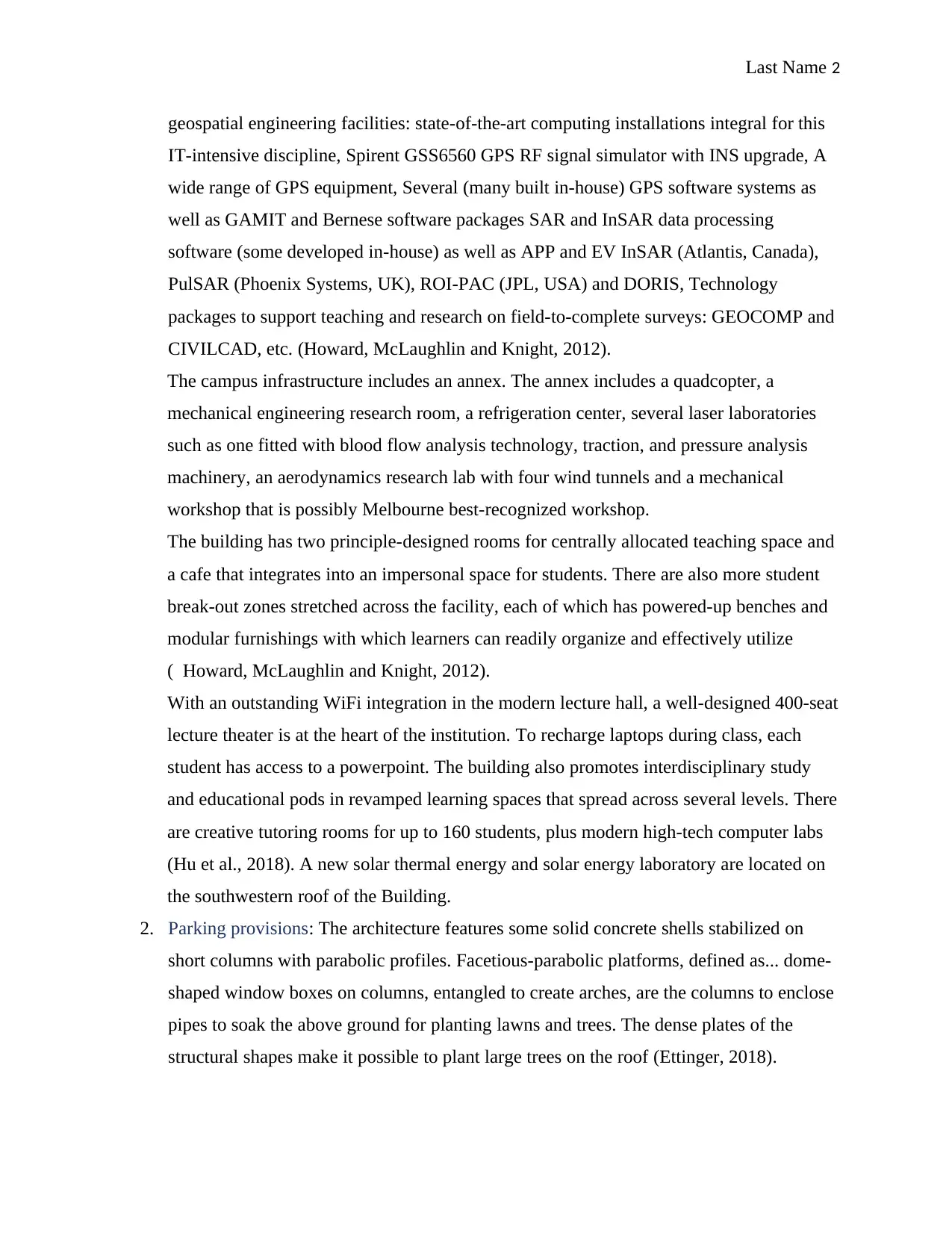
Last Name 2
geospatial engineering facilities: state-of-the-art computing installations integral for this
IT-intensive discipline, Spirent GSS6560 GPS RF signal simulator with INS upgrade, A
wide range of GPS equipment, Several (many built in-house) GPS software systems as
well as GAMIT and Bernese software packages SAR and InSAR data processing
software (some developed in-house) as well as APP and EV InSAR (Atlantis, Canada),
PulSAR (Phoenix Systems, UK), ROI-PAC (JPL, USA) and DORIS, Technology
packages to support teaching and research on field-to-complete surveys: GEOCOMP and
CIVILCAD, etc. (Howard, McLaughlin and Knight, 2012).
The campus infrastructure includes an annex. The annex includes a quadcopter, a
mechanical engineering research room, a refrigeration center, several laser laboratories
such as one fitted with blood flow analysis technology, traction, and pressure analysis
machinery, an aerodynamics research lab with four wind tunnels and a mechanical
workshop that is possibly Melbourne best-recognized workshop.
The building has two principle-designed rooms for centrally allocated teaching space and
a cafe that integrates into an impersonal space for students. There are also more student
break-out zones stretched across the facility, each of which has powered-up benches and
modular furnishings with which learners can readily organize and effectively utilize
( Howard, McLaughlin and Knight, 2012).
With an outstanding WiFi integration in the modern lecture hall, a well-designed 400-seat
lecture theater is at the heart of the institution. To recharge laptops during class, each
student has access to a powerpoint. The building also promotes interdisciplinary study
and educational pods in revamped learning spaces that spread across several levels. There
are creative tutoring rooms for up to 160 students, plus modern high-tech computer labs
(Hu et al., 2018). A new solar thermal energy and solar energy laboratory are located on
the southwestern roof of the Building.
2. Parking provisions: The architecture features some solid concrete shells stabilized on
short columns with parabolic profiles. Facetious-parabolic platforms, defined as... dome-
shaped window boxes on columns, entangled to create arches, are the columns to enclose
pipes to soak the above ground for planting lawns and trees. The dense plates of the
structural shapes make it possible to plant large trees on the roof (Ettinger, 2018).
geospatial engineering facilities: state-of-the-art computing installations integral for this
IT-intensive discipline, Spirent GSS6560 GPS RF signal simulator with INS upgrade, A
wide range of GPS equipment, Several (many built in-house) GPS software systems as
well as GAMIT and Bernese software packages SAR and InSAR data processing
software (some developed in-house) as well as APP and EV InSAR (Atlantis, Canada),
PulSAR (Phoenix Systems, UK), ROI-PAC (JPL, USA) and DORIS, Technology
packages to support teaching and research on field-to-complete surveys: GEOCOMP and
CIVILCAD, etc. (Howard, McLaughlin and Knight, 2012).
The campus infrastructure includes an annex. The annex includes a quadcopter, a
mechanical engineering research room, a refrigeration center, several laser laboratories
such as one fitted with blood flow analysis technology, traction, and pressure analysis
machinery, an aerodynamics research lab with four wind tunnels and a mechanical
workshop that is possibly Melbourne best-recognized workshop.
The building has two principle-designed rooms for centrally allocated teaching space and
a cafe that integrates into an impersonal space for students. There are also more student
break-out zones stretched across the facility, each of which has powered-up benches and
modular furnishings with which learners can readily organize and effectively utilize
( Howard, McLaughlin and Knight, 2012).
With an outstanding WiFi integration in the modern lecture hall, a well-designed 400-seat
lecture theater is at the heart of the institution. To recharge laptops during class, each
student has access to a powerpoint. The building also promotes interdisciplinary study
and educational pods in revamped learning spaces that spread across several levels. There
are creative tutoring rooms for up to 160 students, plus modern high-tech computer labs
(Hu et al., 2018). A new solar thermal energy and solar energy laboratory are located on
the southwestern roof of the Building.
2. Parking provisions: The architecture features some solid concrete shells stabilized on
short columns with parabolic profiles. Facetious-parabolic platforms, defined as... dome-
shaped window boxes on columns, entangled to create arches, are the columns to enclose
pipes to soak the above ground for planting lawns and trees. The dense plates of the
structural shapes make it possible to plant large trees on the roof (Ettinger, 2018).
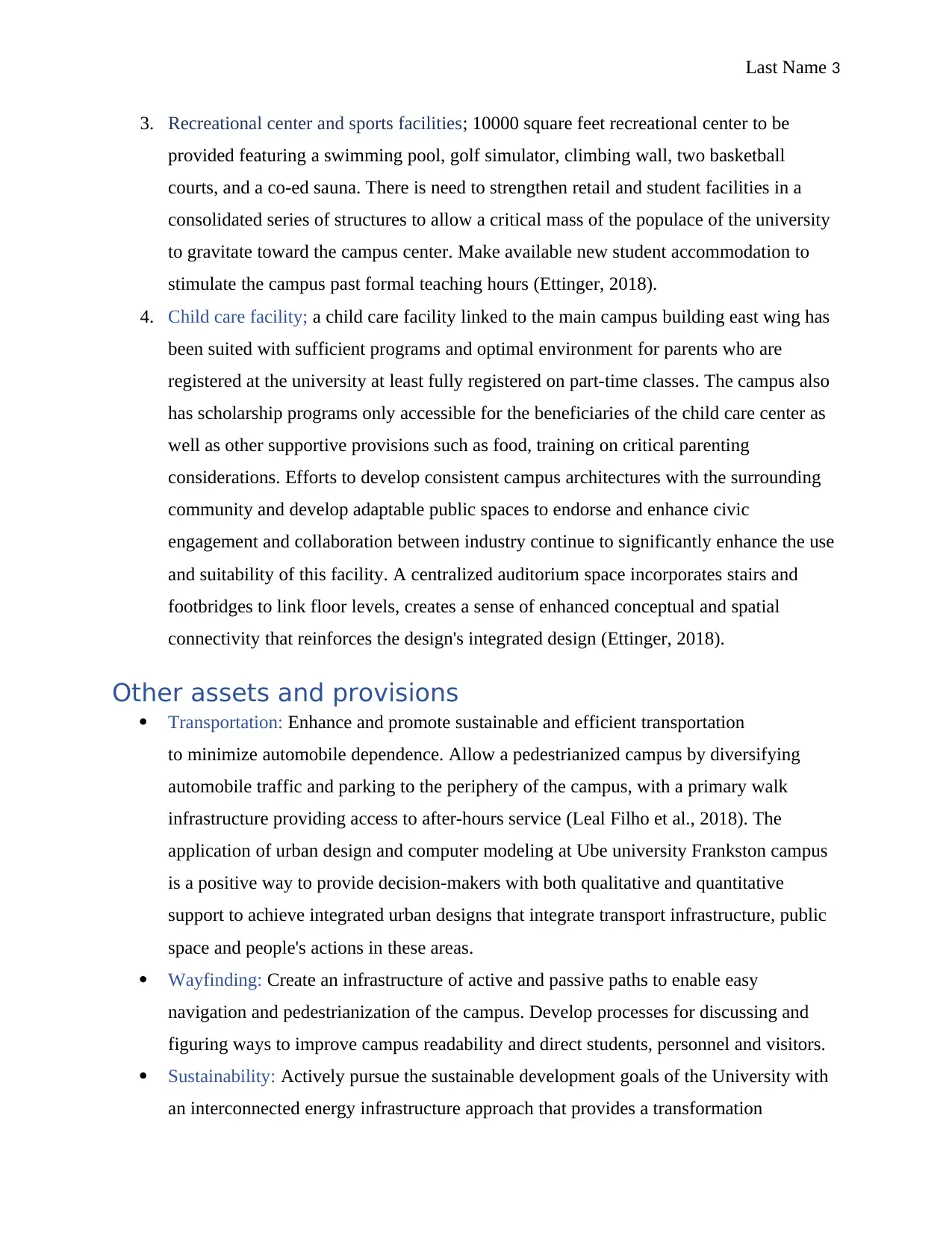
Last Name 3
3. Recreational center and sports facilities; 10000 square feet recreational center to be
provided featuring a swimming pool, golf simulator, climbing wall, two basketball
courts, and a co-ed sauna. There is need to strengthen retail and student facilities in a
consolidated series of structures to allow a critical mass of the populace of the university
to gravitate toward the campus center. Make available new student accommodation to
stimulate the campus past formal teaching hours (Ettinger, 2018).
4. Child care facility; a child care facility linked to the main campus building east wing has
been suited with sufficient programs and optimal environment for parents who are
registered at the university at least fully registered on part-time classes. The campus also
has scholarship programs only accessible for the beneficiaries of the child care center as
well as other supportive provisions such as food, training on critical parenting
considerations. Efforts to develop consistent campus architectures with the surrounding
community and develop adaptable public spaces to endorse and enhance civic
engagement and collaboration between industry continue to significantly enhance the use
and suitability of this facility. A centralized auditorium space incorporates stairs and
footbridges to link floor levels, creates a sense of enhanced conceptual and spatial
connectivity that reinforces the design's integrated design (Ettinger, 2018).
Other assets and provisions
Transportation: Enhance and promote sustainable and efficient transportation
to minimize automobile dependence. Allow a pedestrianized campus by diversifying
automobile traffic and parking to the periphery of the campus, with a primary walk
infrastructure providing access to after-hours service (Leal Filho et al., 2018). The
application of urban design and computer modeling at Ube university Frankston campus
is a positive way to provide decision-makers with both qualitative and quantitative
support to achieve integrated urban designs that integrate transport infrastructure, public
space and people's actions in these areas.
Wayfinding: Create an infrastructure of active and passive paths to enable easy
navigation and pedestrianization of the campus. Develop processes for discussing and
figuring ways to improve campus readability and direct students, personnel and visitors.
Sustainability: Actively pursue the sustainable development goals of the University with
an interconnected energy infrastructure approach that provides a transformation
3. Recreational center and sports facilities; 10000 square feet recreational center to be
provided featuring a swimming pool, golf simulator, climbing wall, two basketball
courts, and a co-ed sauna. There is need to strengthen retail and student facilities in a
consolidated series of structures to allow a critical mass of the populace of the university
to gravitate toward the campus center. Make available new student accommodation to
stimulate the campus past formal teaching hours (Ettinger, 2018).
4. Child care facility; a child care facility linked to the main campus building east wing has
been suited with sufficient programs and optimal environment for parents who are
registered at the university at least fully registered on part-time classes. The campus also
has scholarship programs only accessible for the beneficiaries of the child care center as
well as other supportive provisions such as food, training on critical parenting
considerations. Efforts to develop consistent campus architectures with the surrounding
community and develop adaptable public spaces to endorse and enhance civic
engagement and collaboration between industry continue to significantly enhance the use
and suitability of this facility. A centralized auditorium space incorporates stairs and
footbridges to link floor levels, creates a sense of enhanced conceptual and spatial
connectivity that reinforces the design's integrated design (Ettinger, 2018).
Other assets and provisions
Transportation: Enhance and promote sustainable and efficient transportation
to minimize automobile dependence. Allow a pedestrianized campus by diversifying
automobile traffic and parking to the periphery of the campus, with a primary walk
infrastructure providing access to after-hours service (Leal Filho et al., 2018). The
application of urban design and computer modeling at Ube university Frankston campus
is a positive way to provide decision-makers with both qualitative and quantitative
support to achieve integrated urban designs that integrate transport infrastructure, public
space and people's actions in these areas.
Wayfinding: Create an infrastructure of active and passive paths to enable easy
navigation and pedestrianization of the campus. Develop processes for discussing and
figuring ways to improve campus readability and direct students, personnel and visitors.
Sustainability: Actively pursue the sustainable development goals of the University with
an interconnected energy infrastructure approach that provides a transformation
⊘ This is a preview!⊘
Do you want full access?
Subscribe today to unlock all pages.

Trusted by 1+ million students worldwide
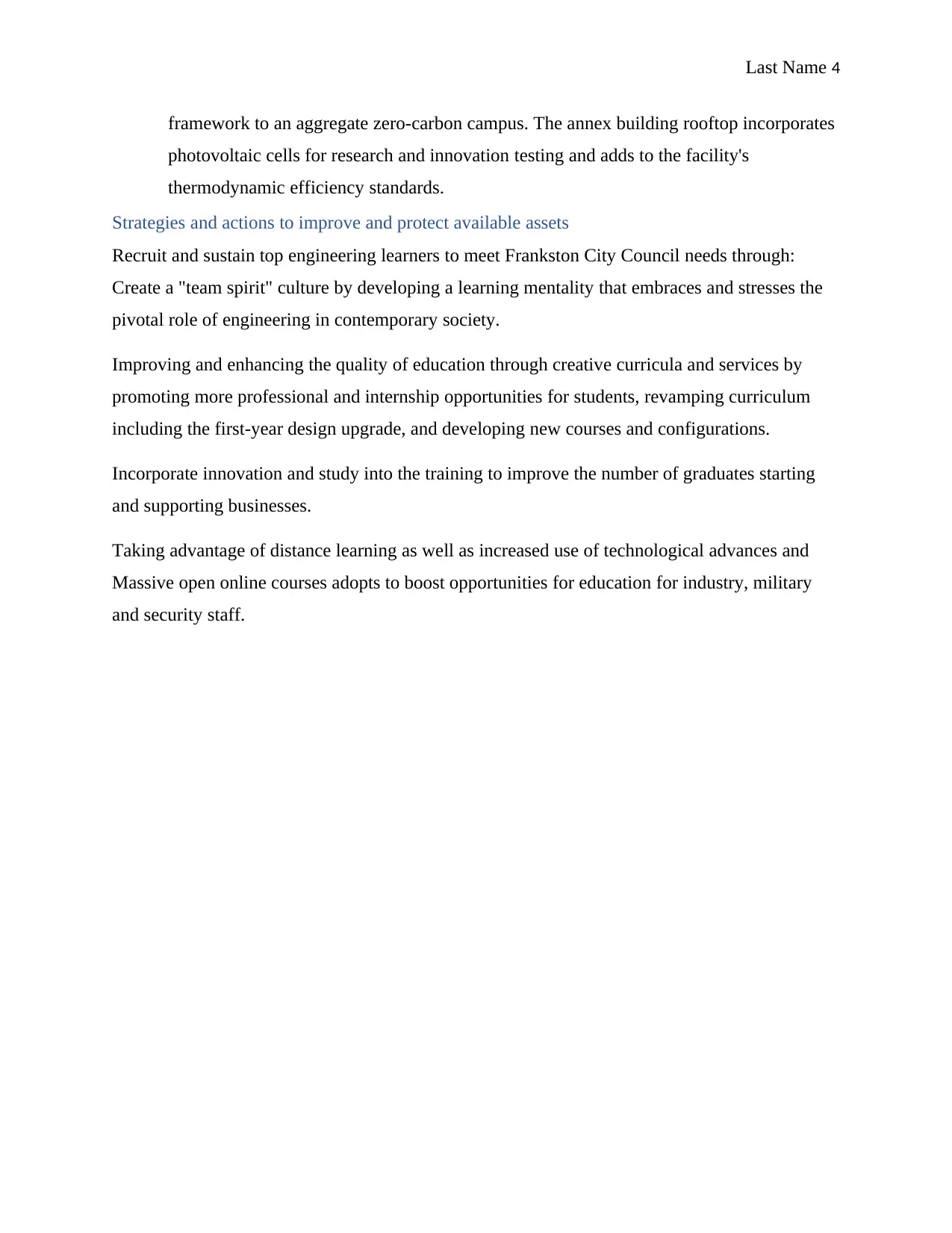
Last Name 4
framework to an aggregate zero-carbon campus. The annex building rooftop incorporates
photovoltaic cells for research and innovation testing and adds to the facility's
thermodynamic efficiency standards.
Strategies and actions to improve and protect available assets
Recruit and sustain top engineering learners to meet Frankston City Council needs through:
Create a "team spirit" culture by developing a learning mentality that embraces and stresses the
pivotal role of engineering in contemporary society.
Improving and enhancing the quality of education through creative curricula and services by
promoting more professional and internship opportunities for students, revamping curriculum
including the first-year design upgrade, and developing new courses and configurations.
Incorporate innovation and study into the training to improve the number of graduates starting
and supporting businesses.
Taking advantage of distance learning as well as increased use of technological advances and
Massive open online courses adopts to boost opportunities for education for industry, military
and security staff.
framework to an aggregate zero-carbon campus. The annex building rooftop incorporates
photovoltaic cells for research and innovation testing and adds to the facility's
thermodynamic efficiency standards.
Strategies and actions to improve and protect available assets
Recruit and sustain top engineering learners to meet Frankston City Council needs through:
Create a "team spirit" culture by developing a learning mentality that embraces and stresses the
pivotal role of engineering in contemporary society.
Improving and enhancing the quality of education through creative curricula and services by
promoting more professional and internship opportunities for students, revamping curriculum
including the first-year design upgrade, and developing new courses and configurations.
Incorporate innovation and study into the training to improve the number of graduates starting
and supporting businesses.
Taking advantage of distance learning as well as increased use of technological advances and
Massive open online courses adopts to boost opportunities for education for industry, military
and security staff.
Paraphrase This Document
Need a fresh take? Get an instant paraphrase of this document with our AI Paraphraser
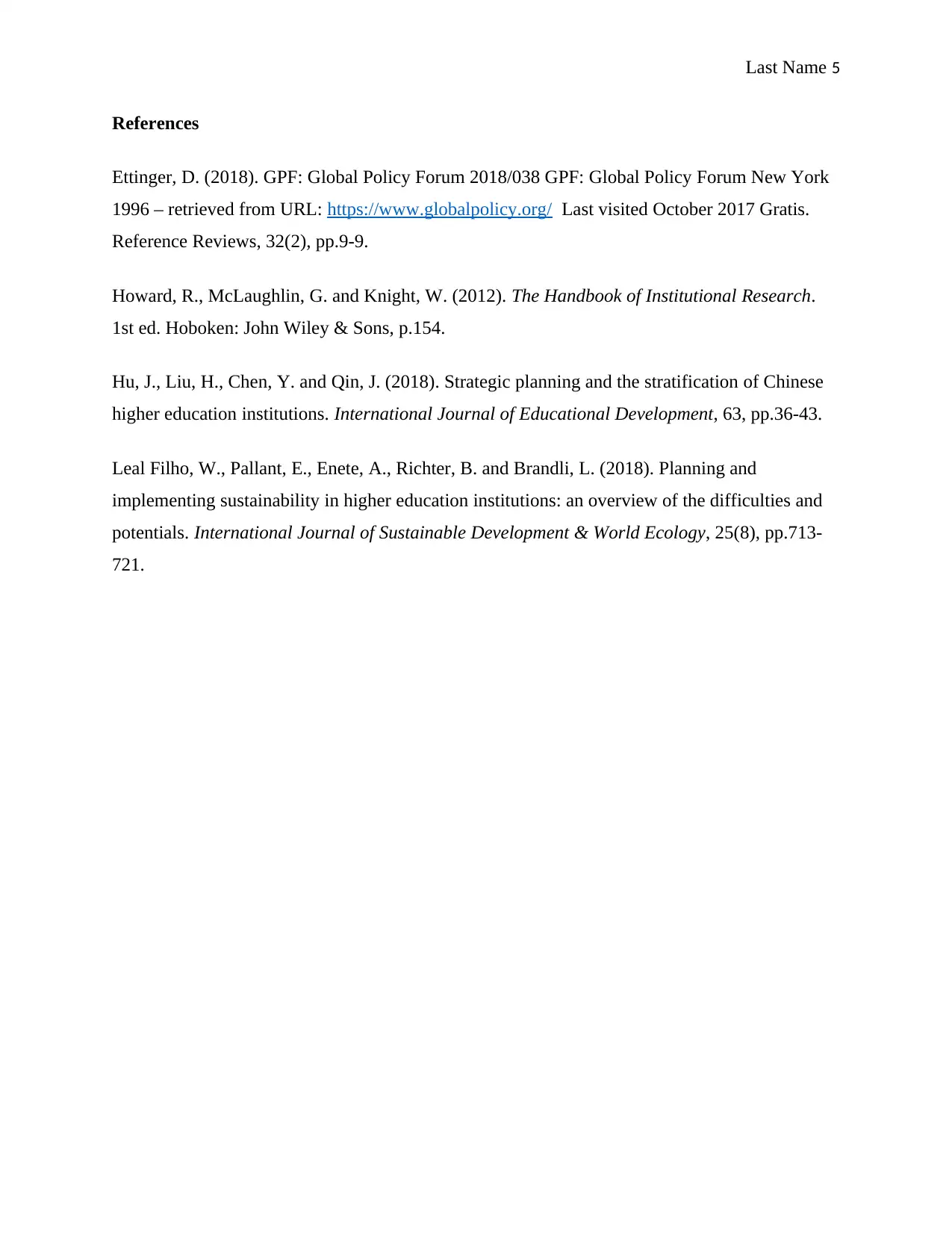
Last Name 5
References
Ettinger, D. (2018). GPF: Global Policy Forum 2018/038 GPF: Global Policy Forum New York
1996 – retrieved from URL: https://www.globalpolicy.org/ Last visited October 2017 Gratis.
Reference Reviews, 32(2), pp.9-9.
Howard, R., McLaughlin, G. and Knight, W. (2012). The Handbook of Institutional Research.
1st ed. Hoboken: John Wiley & Sons, p.154.
Hu, J., Liu, H., Chen, Y. and Qin, J. (2018). Strategic planning and the stratification of Chinese
higher education institutions. International Journal of Educational Development, 63, pp.36-43.
Leal Filho, W., Pallant, E., Enete, A., Richter, B. and Brandli, L. (2018). Planning and
implementing sustainability in higher education institutions: an overview of the difficulties and
potentials. International Journal of Sustainable Development & World Ecology, 25(8), pp.713-
721.
References
Ettinger, D. (2018). GPF: Global Policy Forum 2018/038 GPF: Global Policy Forum New York
1996 – retrieved from URL: https://www.globalpolicy.org/ Last visited October 2017 Gratis.
Reference Reviews, 32(2), pp.9-9.
Howard, R., McLaughlin, G. and Knight, W. (2012). The Handbook of Institutional Research.
1st ed. Hoboken: John Wiley & Sons, p.154.
Hu, J., Liu, H., Chen, Y. and Qin, J. (2018). Strategic planning and the stratification of Chinese
higher education institutions. International Journal of Educational Development, 63, pp.36-43.
Leal Filho, W., Pallant, E., Enete, A., Richter, B. and Brandli, L. (2018). Planning and
implementing sustainability in higher education institutions: an overview of the difficulties and
potentials. International Journal of Sustainable Development & World Ecology, 25(8), pp.713-
721.
1 out of 5
Your All-in-One AI-Powered Toolkit for Academic Success.
+13062052269
info@desklib.com
Available 24*7 on WhatsApp / Email
![[object Object]](/_next/static/media/star-bottom.7253800d.svg)
Unlock your academic potential
Copyright © 2020–2025 A2Z Services. All Rights Reserved. Developed and managed by ZUCOL.